Edgewater (Barrytown, New York)
Edgewater is a historic house near Barrytown in Dutchess County, New York, United States. Built about 1824,[3] the house is a contributing property to the Hudson River Historic District.[4] Edgewater's principal architectural feature is a monumental colonnade of six Doric columns, looking out across a lawn to the Hudson River. Writing in 1942, the historians Eberlein and Hubbard described Edgewater as an exemplar of "the combined dignity and subtle grace that marked the houses of the Federal Era." [5]
Edgewater | |
_at_Edgewater_in_Barrytown_New_York_(2018).jpg.webp) West Facade of Edgewater in 2018. | |
| Location | Barrytown, New York |
|---|---|
| Part of | Hudson River Historic District |
| NRHP reference No. | 90002219 |
| Significant dates | |
| Added to NRHP | December 14, 1990[1] |
| Designated CP | December 14, 1990[2] |
History
_-_George_Cooke.jpg.webp)
1820–1853 (Livingston Family)
The history of Edgewater dates back to December 23, 1819, when Bishop Hobart of New York City married "Lowndes Brown, esq. of Charleston S.C. to Miss Margaretta Livingston, daughter of John R. Livingston, esq." [6] The groom, Rawlins Lowndes Brown (1792–1852), was a graduate of Yale, class of 1806, and had been (as recently as September 1819 when he resigned his commission) Captain Lowndes Brown in charge of Company G stationed on Governors Island.[7]
In 1824, possibly as a belated wedding gift, John R. Livingston gave the 250-acre Edgewater property to his daughter and son-in-law, and the house may have been built about that time.[8]
1853–1902 (Donaldson Family)
The New York financier and aesthete Robert Donaldson Jr. (1800–1872) bought Edgewater in 1853.[9] Donaldson engaged the architect Alexander Jackson Davis (1803–1892) to add an octagonal library wing, and to clad the brick house with brownstone tinted stucco.[10] Davis also designed two gatehouses.[11] In 1902, the executor of the Donaldson estate sold the house to Elizabeth Chapman (1866-1937).[12]
1902–1946 (Chapman Family)
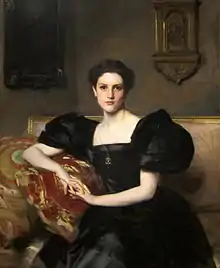
Elizabeth Chapman was the second wife of the essayist John Jay Chapman. Born Elizabeth Astor Winthrop Chanler, the daughter of John Winthrop Chanler and Margaret Astor Ward, she grew up at Rokeby, a nearby house. Elizabeth Chapman probably never occupied Edgewater, or if she did, it was not for long—in 1906, she and her husband moved into a new house designed by the architect Charles A. Platt, built on the hill above Edgewater and known as Sylvania. However, her mother-in-law, Eleanor Jay Chapman (a great-granddaughter of Supreme Court Chief Justice John Jay) lived at Edgewater from 1910 until at least 1914.[13][14]
In 1917, Elizabeth Chapman sold the Edgewater property (not including either gate house) to her stepson Conrad Chapman (1896–1989) for $1.00. He probably never occupied the house either as he lived abroad during most of his time as Edgewater's freeholder.[15] In 1946, Conrad Chapman sold Edgewater to Laura M. Taylor for $1.00.
1946–1950 (Taylor Family)
Robert Kirby Taylor and Laura Scantlin were married at Pittsburg in 1907,[16] and as of 1940, they were living at 444 East 58th Street in New York City, where Taylor worked as a "woolen merchant."[17] In November 1944, they were in Cold Spring, New York when their son's house was destroyed by fire.[18] Sometime later, they leased Edgewater where Robert Taylor died in June 1946.[19] One month later, Laura Taylor bought Edgewater, holding it until 1950 when she sold to the writer Gore Vidal.[20]
1950–1969 (Gore Vidal)
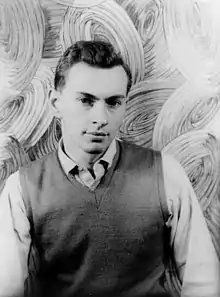
Gore Vidal bought Edgewater at the recommendation of his friend, Alice Astor Bouverie.[21] In 1960, he ran as the Democratic candidate for Congress for the 29th Congressional District of New York State, using Edgewater as his campaign headquarters. He lost to the Republican candidate J. Ernest Wharton, by a margin of 57 percent to 43 percent.[22] Among Vidal's supporters were Eleanor Roosevelt, Paul Newman and Joanne Woodward, all of whom spoke on his behalf.[23]
In November 1966, Vidal, now living in Italy, rented Edgewater to William vanden Heuvel, a lawyer, aide to Robert F. Kennedy, and husband of the writer Jean Stein.[24] In 1969, Vidal sold Edgewater to Richard Jenrette.
1969–2018 (Richard H. Jenrette)
New York financier and preservationist Richard Jenrette bought Edgewater from Gore Vidal in 1969, by which time the house sat on 2.69 acres.[25] During his tenure, Jenrette completed a restoration of the house and bought back much of the acreage (although not the two gatehouses). He also commissioned two new buildings, a classical pavilion (1997) and poolhouse (1998), designed by the architect Michael Dwyer.[26] Jenrette died at Charleston, South Carolina on April 22, 2018.
2018–Present (CAHPT)
Edgewater is currently owned by the Classical American Homes Preservation Trust, a foundation created by Richard Jenrette.
Gallery
.jpg.webp) Map Excerpt, showing Edgewater in 1850.
Map Excerpt, showing Edgewater in 1850..jpg.webp) Map Excerpt, showing Edgewater (aka Riverside) in 1858.
Map Excerpt, showing Edgewater (aka Riverside) in 1858. Map Excerpt, showing Edgewater in 1867.
Map Excerpt, showing Edgewater in 1867. Main Floor Plan of Edgewater based on Measurements taken about 1974.
Main Floor Plan of Edgewater based on Measurements taken about 1974.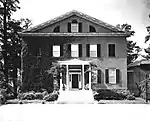 A Photograph of the Entrance (East) Facade at Edgewater, taken September 1979.
A Photograph of the Entrance (East) Facade at Edgewater, taken September 1979..jpg.webp) Entrance (East) Facade at Edgewater, taken October 2018.
Entrance (East) Facade at Edgewater, taken October 2018.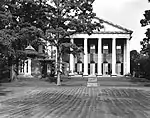 West Facade of Edgewater in 1979.
West Facade of Edgewater in 1979.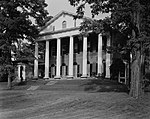 A Photograph of the River (West) Facade at Edgewater, taken September 1979.
A Photograph of the River (West) Facade at Edgewater, taken September 1979._at_Edgewater_in_Barrytown_New_York_(2018).jpg.webp) North and West Facade, taken October 2018.
North and West Facade, taken October 2018. The architect Alexander Jackson Davis added an octagonal wing to Edgewater in the 1850s.
The architect Alexander Jackson Davis added an octagonal wing to Edgewater in the 1850s. The South Gatehouse at Edgewater, designed by the architect Alexander J. Davis.
The South Gatehouse at Edgewater, designed by the architect Alexander J. Davis. The North Gatehouse at Edgewater, designed by the architect Alexander J. Davis.
The North Gatehouse at Edgewater, designed by the architect Alexander J. Davis.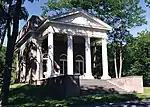 The Garden Pavilion at Edgewater, designed by the architect Michael Dwyer.
The Garden Pavilion at Edgewater, designed by the architect Michael Dwyer.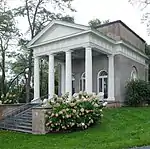 River Facade of the Garden Pavilion in 2018.
River Facade of the Garden Pavilion in 2018. Venetian Window of the Garden Pavilion in 2018.
Venetian Window of the Garden Pavilion in 2018.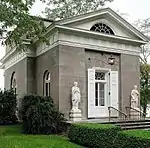 Entrance Facade of the Garden Pavilion in 2018.
Entrance Facade of the Garden Pavilion in 2018.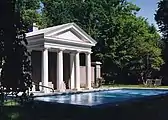 Poolhouse at Edgewater, designed by the architect Michael Dwyer.
Poolhouse at Edgewater, designed by the architect Michael Dwyer.
Further reading
- Life Along the Hudson, Pieter Estersohn, New York, NY: Rizzoli, 2018.
- Private Gardens of the Hudson Valley, Jane Garmey, New York, NY: Monacelli Press, 2013.
- More Adventures with Old Houses, Richard H. Jenrette, New York, NY: Classical American Homes Preservation Trust, 2010. ISBN 9780982573709.
- Great Houses of the Hudson River, Michael Middleton Dwyer, editor, with preface by Mark Rockefeller, Boston, MA: Little, Brown and Company, published in association with Historic Hudson Valley, 2001. ISBN 082122767X.
- Adventures with Old Houses, Richard H. Jenrette, Charleston, SC: Wyrick & Co., 2000. ISBN 0941711463.
- Gore Vidal: A Biography, Fred Kaplan, Doubleday, 1999. ISBN 0385477031.
- Carolinian on the Hudson: the Life of Robert Donaldson, Jean Bradley Anderson, Raleigh, NC: Historic Preservation Foundation of North Carolina, 1996.
- Palimpsest: A Memoir, Gore Vidal, New York, NY: Random House, 1995. ISBN 0679440380.
- William Nathaniel Banks, "Living with Antiques: Edgewater on the Hudson River," The Magazine Antiques, vol. 121, no. 6 (June 1982), pp. 1400–1410.
- Historic Houses of the Hudson Valley, Harold Donaldson Eberlin and Cortland Van Dyke Hubbard, New York, NY: Architectural Book Publishing Co., Inc., 1942.
External links
| Wikimedia Commons has media related to Edgewater (Barrytown, New York). |
References
- "National Register Information System". National Register of Historic Places. National Park Service. January 23, 2007.
- "Hudson River Historic District". National Historic Landmark summary listing. National Park Service. 2007-09-14. Archived from the original on 2012-09-01.
- The house was built about 1820, according to William Nathaniel Banks, writing in "Edgewater on the Hudson River," The Magazine Antiques, June 1982.
- Neil Larson (September 19, 1990), National Register of Historic Places Registration: Hudson River Historic District (pdf), National Park Service
- Harold Donaldson Eberlein and Cortlandt Van Dyke Hubbard, Historic Houses of the Hudson Valley (1942), page 93.
- The Evening Post (New York), December 24, 1819, page 2.
- The Evening Post (New York), September 1, 1819, page 1.
- Deed recorded November 29, 1824, John R. Livingston to Margaretta Brown and Captain Lowndes Brown (gift).
- Deed recorded February 3, 1853, Margaret L. Brown to Robert Donaldson, for $22,500.
- William Nathaniel Banks, "Edgewater on the Hudson," The Magazine Antiques, June 1982.
- Historic American Buildings Survey, Report No. NY-5621, Data Pages, 1981.
- Deed recorded September 17, 1902, Robert Bronson, executor, to Elizabeth Chapman, for $20,000.
- Social Register Association, New York 1911 Social Register, November 1910, page 105.
- Social Register Association, New York 1915 Social Register, 1914, page 115.
- Conrad Chapman's address in his 1921 NY Social Register entry was Oxford, England, and in the 1931 edition, Paris.
- The Washington Post, July 28, 1907, page 3.
- 1940 U.S. Census, Manhattan, Assembly District 14.
- "Dog Barks Alarm, Dies in Fire," The New York Times, November 18, 1944, page 15.
- The New York Times, June 11, 1946, page 20.
- Deed recorded July 26, 1950, Laura M. Taylor to Gore Vidal, for $16,000.
- Gore Vidal, "How I Survived the Fifties," The New Yorker, October 2, 1995, page 62.
- "Statistics of the Presidential and Congressional Election of November 8, 1960" (PDF). Office of the Clerk, U.S. House of Representatives. 1960. p. 31, item #29. Retrieved August 4, 2012.
- Freeman, Ira Henry (September 15, 1960). "The Playwright, the Lawyer, and the Voters". New York Times. p. 20.
- The Philadelphia Inquirer, November 9, 1966, page 36.
- Deed recorded December 30, 1969, Gore Vidal to Richard H. Jenrette, for $125,000.
- Richard H. Jenrette, Adventures with Old Houses (Charleston, SC: Wyrick & Co., 2000). ISBN 0-941711-46-3.